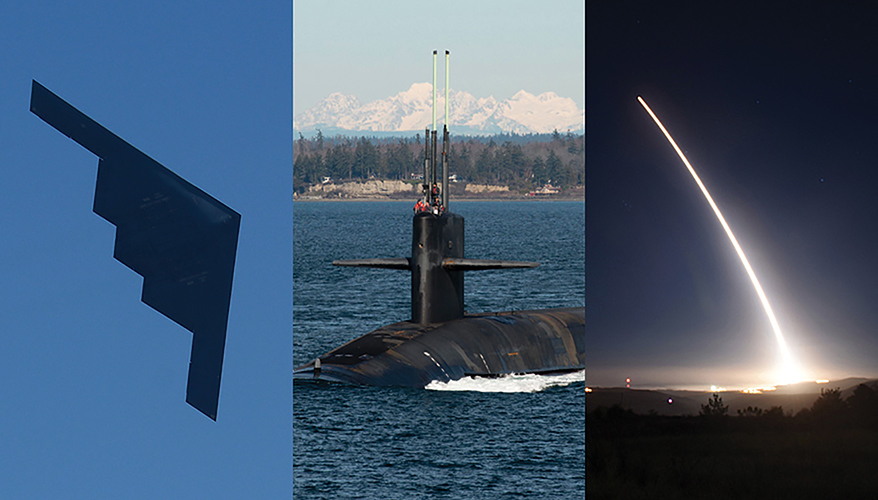 Department of Defense
Department of Defense
Challenges With Modernizing the Nuclear Triad
As a candidate, Joe Biden campaigned on opposing new nuclear weapons programs. President Joe Biden, contrary to prior expectations due to his past friendliness to arms control, has released a budget that would expand America’s nuclear capabilities.
This follows a trend across administrations. The Obama Administration began the development of the Ground-Based Strategic Deterrent (GBSD). The Trump Administration continued the modernization process by installing low-yield warheads onto submarine-launched missiles and initiating research into developing new sea-launched nuclear cruise missiles (SLCM-N). President Biden’s proposed budget keeps these new programs and requests even more money than was projected by the Trump Administration for the Long Range Standoff Weapon (LRSO). The future of these programs depends on the Biden Administration’s Nuclear Posture Review, which will make it clear where the Administration stands on modernization and the nuclear triad. If the budget proposal is any indication, then President Biden seems inclined to continue on the path he inherited from his predecessor.
The new budget brings up questions about the value of the modernization program and whether it will improve the deterrent effect of the nuclear forces while reducing the cost of maintenance. The increased projected cost of the modernization program has caused many in Congress to voice concerns about the strategic value of ICBMs and the necessity of maintaining a large ICBM force.
The new budget proposal includes significant increases in spending on nuclear weapons. For example, the Biden budget seeks to raise GBSD funding from $1.45 to $2.6 billion, LRSO from $385 to $689 million, and new funding for the SCLM-N to the tune of $15 million (though it appears the Navy wants it phased out by 2023).
The increase in GBSD funding has created tension between two groups. The first group says there’s no longer a need for a land-based nuclear deterrent and nuclear spending should be reduced and those funds allocated elsewhere. The second group includes Congressional hawks and military officials who argue that modernization of all components of the nuclear triad is necessary to keep up with Russian and Chinese developments.
Opponents of the GSBD program argue that the Minuteman III ICBM is still active and usable and there is no need for a new system when the existing one works fine. Furthermore, they argue submarine-based missiles are difficult to locate and air-based missiles allow for greater flexibility, whereas ICBMs are on constant high-alert, would be the first targets hit by a surprise attack, and give no room for flexibility (“use it or lose it”).
The Pentagon believes that if the GBSD is scrapped, the US risks falling behind in having a credible land-based nuclear deterrent. It has long argued that even though the Minuteman III is still able to meet the needs of national security, it has run its course, was never designed to be deployed for this long, and an alternative is necessary to replace it. It estimated in 2016 that over the 50-year lifespan of the GBSD, it would cost $159 billion, in contrast to the cost of maintaining the Minuteman III for the same period estimated at $160.3 billion, a gap of $1.1 billion which has since grown to $38 billion in favor of the GBSD.
Is it worth it to spend so much money on modernizing all three legs of the nuclear triad when there are other more pressing concerns that require attention and funding? Reducing the amount and role of ICBMs, and nuclear weapons in general, is a desirable outcome and an achievable goal, especially if done within a treaty interface with Russia and possibly China. Without such mechanisms, it is harder to convince Russia or others to also make reductions of their own. At the same time, the United States should not allow Russia’s or China’s defense spending choices to dictate its own, and it is under no obligation to tie further reductions beyond treaty limits to another country’s arsenal. Considering this, if the goal is to use treaty mechanisms to reduce the threat from Russia or China, a land-based nuclear deterrent could be maintained as a useful bargaining chip. However, if the price tag of the GBSD continues to increase, alternatives that uphold the effectiveness of the nuclear deterrent should be entertained. A similar approach should be taken with air- and sea-based missiles. Overall, the Biden Administration’s upcoming Nuclear Posture Review will provide a clearer vision of the direction of America’s nuclear modernization.





